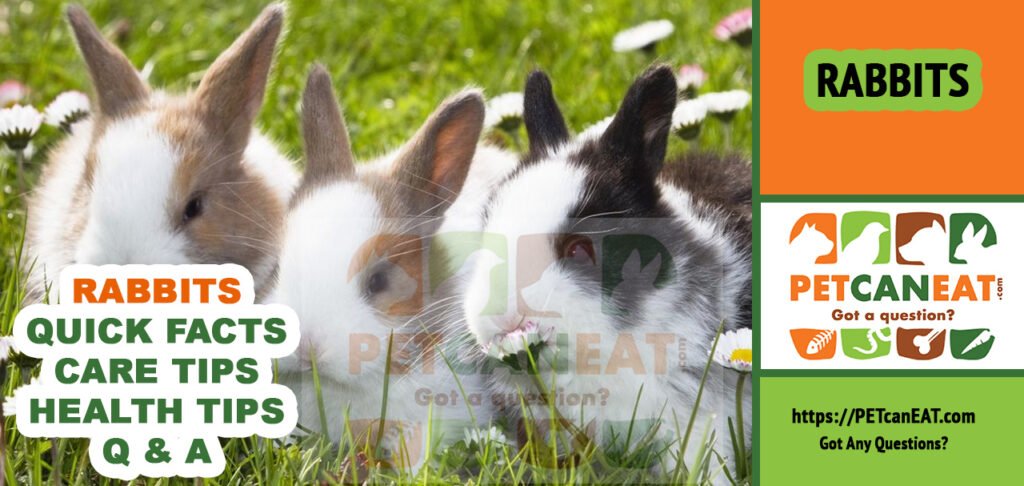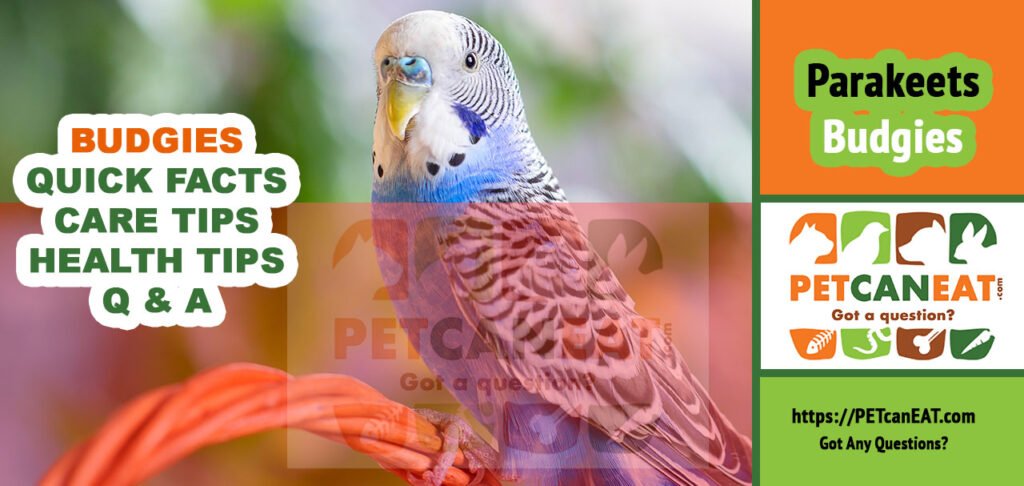Rabbits can make incredibly good pets, but they have very specific needs. Before buying a rabbit, you must be sure you have the space, time, and money to raise a happy, healthy rabbit.
Rabbits can live up to 12 years — that is a huge commitment. If the rabbit is for your children, will they go to university in the rabbit’s lifetime? Will they become bored? If the rabbit is for you, will you always have the large amount of space that a rabbit needs? Think about everything and do your research.
Before buying a rabbit
Things to consider before becoming a rabbit owner:
Is a rabbit a good pet for you?
Many rabbits don’t enjoy being picked up or cuddled and can kick and scratch out of fear. Rabbits should only be handled when necessary — although, with a lot of patience, training, and effort from you, some rabbits will tolerate or even enjoy handling. Rabbits can also live for up to ten to 12 years (depending on the breed) and are a big commitment. You should consider both of these points when taking on a rabbit as a child’s pet.
Do you have space for a rabbit?
Wild rabbits cover many miles daily searching for food and live in large groups of up to 30 in rabbit warrens. Pet rabbits also need a lot of space to live in and a hutch to shelter and rest in. A suitably sized rabbit enclosure will take up a large garden area — do you have the space for it?
Can you afford to care for a rabbit?
In addition to the costs of setting up a suitably sized enclosure for our rabbit, which can be up to $500, you will also need to budget for yearly vaccinations and insurance for your rabbit in case of injury or illness.
It has been known for rabbit vet bills to add over $1,000.
Do you have time to care for a rabbit?
Will you have time in your day to socialize with your rabbit, perform daily health checks, feed and clean out your rabbit’s enclosure?
You’ll have to get two rabbits!
Rabbits need the company of another rabbit to stay happy and healthy — if you choose to own a pet rabbit, you’ll need to be willing to own two — that’s twice the cost, space, and time required to look after your rabbits!
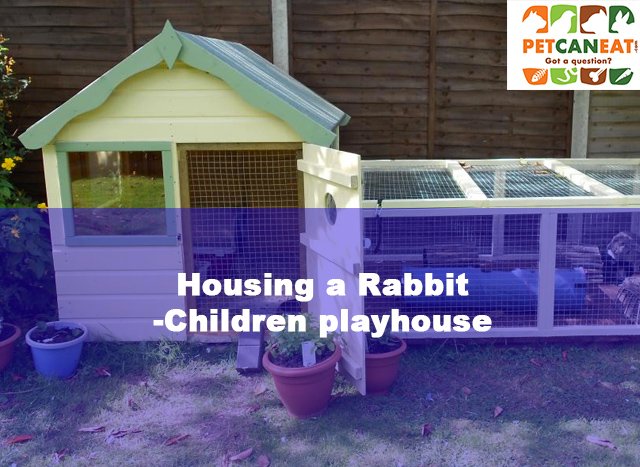
Tips for Housing your rabbits
- When choosing a living environment for your rabbits, the general rule is the bigger, the better. We recommend that a rabbit’s hutch be at least 6ft by 6ft square and at least 3ft tall to allow your rabbit to run, hop, and sprawl out. He should also stretch up on his hind legs without his ears touching the top of the enclosure.
- Your rabbit should always have free access to a run attached to the hutch. The run will mean your rabbit has space to run freely, while a hutch will provide somewhere for your rabbit to rest and shelter.
- Rabbits are most active from early evening into the night and early in the morning, so the best care scenario is for your rabbit to have constant access to both the hutch and run at all times.
- You can be creative with what you use for your rabbit’s hutch — it doesn’t have to be a typical hutch. A small playhouse for children, AKA an old Wendy’s house or garden shed with a cat flap attached to a run, could also be used, as long as it is safe from predators and secure to prevent escape.
- Your rabbit’s enclosure should be placed in a quiet garden area, out of direct sunlight.
- Remember, too, that your rabbit will need the company of another rabbit to stay happy, so you will need to offer space for two rabbits.
Tips and how to Enrich your rabbit’s environment
- Use your rabbit’s food to enrich his environment. Place it up high in holders and hanging baskets so he can stretch up to eat. Scatter food so that your rabbit has to work for his food.
- Puzzle feeders are also available.
- You can also make a hay kebab using toilet rolls to make food more interesting.
- Tunnels mimic a rabbit run in the wild and are fun for your rabbit to run through. You can even use tunnels to connect the hutch to the run or even to a couple of smaller runs. This is particularly useful if you are limited in space.
- Place logs around the enclosure for him to hop on and off; he will also enjoy chewing the bark, which will, in turn, be good for his teeth.
- Use your imagination to provide interesting places for your rabbit to hide.
- Anything you can find can be used, including buckets, off-cuts of drainpipe, and even cardboard boxes.
- Trays filled with soil will provide somewhere for your rabbit to dig.
- Try to ensure that you always keep your rabbit’s environment varied and interesting.
- Change the layout of the enclosure regularly when you clean your rabbit out and introduce new items regularly.
Can you litter train a rabbit? How to litter train a rabbit
Yes. Litter training your rabbit can be useful to help keep his environment clean and tidy and is pretty easy to do, even more so if your rabbit is neutered.
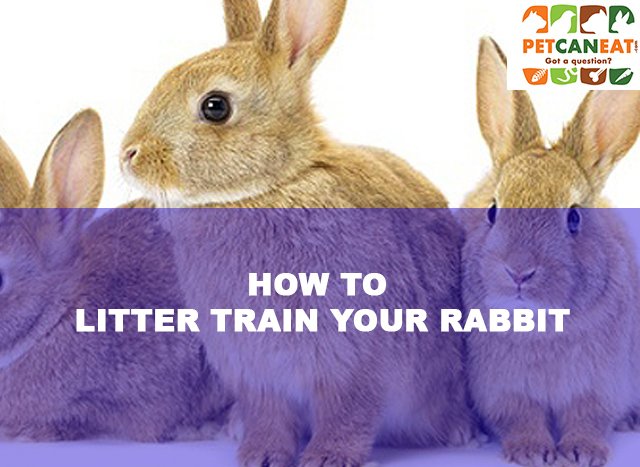
How to litter train a rabbit
Many new rabbit owners may need to learn that litter training a rabbit is possible and not difficult to achieve. Anyone can train their rabbit’s litter habits; this way, keeping the rabbit’s enclosure cleaner is less work for you, especially with the cleaning.
So, how do you litter train your rabbit?
- Watch out for where your rabbit most often goes to the toilet.
- Then, place a litter tray filled with shredded paper in that area.
- Placing a small amount of your rabbit’s soiled bedding may encourage your rabbit to use the area.
- Unlike cats and dogs, rabbits will eat while they are toileting, so providing plenty of hay or grass in the area will encourage your rabbit to toilet there.
Choosing the best bedding for your rabbit
We recommend bedding your rabbit down on hay bedding.
A rabbit will often attempt to eat his bedding, so using something safe to ingest is the safest option. It is also less likely to cause irritation than something like wood shavings.
You can also use Good-quality dust extracted straw. Remember: green hay is safe hay!
Can you keep a rabbit indoors?
Rabbits can exclusively live indoors or be brought inside for winter if needed. They will still require a large amount of space to play in and a secure, quiet area for resting.
It may be best to ‘rabbit-proof’ an entire room, removing all wires and possible poisonous plants.
You can also use a large puppy playpen; remember that you will need the same amount of space indoors as your rabbit has outdoors, with all the necessary enrichment. Access to a good supply of fresh air is essential too. You can provide fresh growing grass in planted trays for your rabbit to nibble on and even plant up herb tubs for him to explore.
Cleaning out hutches and rabbit runs
A clean environment is vital for good rabbit health — a damp, wet environment can cause health and mobility issues in your rabbit.
- Spot cleaning the hutch daily will make the task easier and keep your rabbit’s environment in better condition.
- Every day, you should remove uneaten fresh food and any wet or soiled hay
- Wash out and refill water bowls.
- Spot-clean the litter tray if your rabbit uses one, and spot-clean any other dirty areas of the run or run hutch.
- Once a week, you should empty, wash out, and replace all the litter in the tray (if using one).
- Wash any accessories and toys in the environment and add new enrichment items.
- Wash down any surfaces you can clean with hot water, washout water, and food bowls, and replace all the bedding.
What you need to know about the rabbit
Rabbits deserve their reputation as great pets — friendly, curious, and content to interact with their owners. You and your rabbit will have a long and happy time together with the correct diet, care, and handling. Rabbits can live for up to ten to 12 years (depending on the breed), but some may live for longer.
There are estimated to be around 1.7 million rabbits kept as pets in the UK (according to the PDSA Animal Wellbeing Report 2012), making them the third most popular pet after cats and dogs. There are many different breeds and varieties of pet rabbits, varying in size, body shape, and personality.
Most rabbits don’t enjoy being picked up or handled, but many owners can teach their rabbits to tolerate or even enjoy handling with effort, time, and training.
Where should I get my rabbit from?
If you have decided that you can care for a rabbit properly and are fully committed to his needs, you will need to consider where to find your rabbit. It is highly recommended that you purchase your rabbit from your local rescue center.
Alternatively, If you go to a rescue center, the rabbits in there will have been thoroughly health checked, vaccinated, and neutered before rehoming. The charity can also show you how to properly health check your rabbit and how to trim his claws too.”
Rabbits in rescue centers should have already been paired up with a suitable rabbit companion, too, so you won’t have to worry about your two rabbits not getting along. If you are looking for a companion for your existing rabbit, you may even be able to take him with you to the rescue center to find him a suitable friend.
Buying a rabbit from a pet shop
If you choose to buy a rabbit from a pet shop, firstly remember that you are looking for a pair of rabbits. Ideally, the pair will have lived together before purchasing, so they will both get along. The pet shop should be keeping their rabbits in the right conditions — the rabbits should be bright, alert, and happy — if you are in any doubt about the rabbits’ health, walk away.
A sign of a good pet shop is a good staff. The staff should be knowledgeable about all aspects of rabbit care and be happy to offer you plenty of advice on looking after a rabbit.
A book on rabbit care should also be an essential purchase.
Remember that life in a pet shop may have been quite stressful for your rabbits, so allow more time for them to settle into their new home. Remember to ask whether or not your rabbits have been neutered and vaccinated; if not, get this scheduled for as soon as is suitable when they get home.
If you buy a rabbit from a breeder, you will likely purchase a well-socialized, healthy rabbit that will be happy to be handled. Again look for a knowledgeable owner with healthy-looking, curious rabbits.
What breed of the rabbit should I get?
When choosing which breed of rabbit to buy (remember, you should always keep two rabbits together), many people often think that the smaller dwarf breeds of rabbits are more suitable for children as they are easier to handle. In reality, dwarf breeds are often more challenging to handle as they can be more nervous, fragile, and prone to injury.
We recommend that first-time rabbit owners avoid the larger and smaller breeds that require more specialized care and expertise.
Look for a rabbit which has characteristics similar to a wild rabbit. You should be looking to choose a happy and alert rabbit with a glossy coat and wide eyes. They should appear special in size and friendly.
Different rabbit breeds
There are over 60 different known breeds of rabbits. However, among them, only a handful a popular and known by most.
Here are some of the most popular rabbit breeds around.
Dutch
- Average size: 1.5-2.4kg.
- Average lifespan: Six years.
- Grooming Requirements: happy and alert rabbit is one of the most popular breeds kept as pets. They are easily recognizable due to their white markings, which you can match up with various colors, the most common of these being black.
Himalayan
- Average size: 2kg.
- Average lifespan: Up to eight years.
- Grooming requirements: During molting only.
- This is an old breed renowned for having a friendly temperament but can be slightly aloof. You can find their distinctive markings on their ears, nose, legs, and tail in black, blue, chocolate, or lilac, all with a white body. They have pink or red eyes.
Netherland Dwarf
- Average size: around 0.9kg.
- Average lifespan: Up to eight years.
- Grooming requirements: During molting only.
- The Netherland Dwarf is one of the smallest breeds. They have short ears and a pear-shaped face. They can be flighty and take time to build their trust, so they are not ideal pets for small children. They can be prone to dental disease, so they regularly check their teeth.
New Zealand
- Average size: 4-5.4kg.
- Average lifespan: Five to seven years.
- Grooming Requirements: Weekly, daily when molting.
- Your stereotypical big white bunny! They do molt profusely, so be prepared for lots of hair.
Polish
- Average size: 1kg.
- Average life span: Eight to ten years.
- Grooming Requirements: Only when molting.
- The Polish are small and very lively. They are active, intelligent, and unlikely to sit on your knee for more than a few seconds, so they are not ideal for children. You can find them in a large variety of colors, with albino being a popular choice for showing.
English
- Average size: 2.7-3.6kg.
- This is one of the oldest breeds and is also known as the Old English and English spot.
- They are known for being friendly and lively but are very active so will need plenty of space.
- The markings include a butterfly-shaped mark on the nose, colored ears, eye circles, spine marking (in a herringbone pattern), a spot on each cheek, and a chain of spots along the body.
- You can find them in solid or self colors, as well as ‘Charlies’ that are white with colored heads and a stripe down the back.
English Lop
- Average size: 5-5.5kgs.
- Average life span: Five years.
- Grooming Requirements: Only when molting.
- The English Lop is a slender-built rabbit with long ears. They are friendly rabbits but can be pretty inactive, making them prone to weight gain.
French Lop
- Average size: 4.5kg.
- Average life span: Five years.
- Grooming Requirements: Only when molting.
- The French Lop is generally a good-tempered rabbit that can make a good family pet, but some occurrence of lousy temper is known, and they can grow quite large, so it may not always make the most suitable family pet.
Tips on feeding your rabbit
It’s an absolute myth that rabbits can survive on a diet of rabbit food with the occasional carrot. Hay and grass should make up the bulk of your rabbit’s diet — around 85 percent. A rabbit should, in theory, eat his body weight in hay and grass every day.
This should be scattered around freely in his environment, always to be readily available.
Hay provides the essential fiber your rabbit needs and will also keep his teeth appropriately worn.
Use a variety of different types of meadow hay, ensuring it is fresh and green, not dry and dusty. Ideally, allow your rabbit to graze on your lawn or pick fresh grass for him to munch on from your garden. Don’t feed your rabbit grass clippings.
Feeding your rabbit fresh fruit and vegetables
You should also offer fresh leafy greens and vegetables every day. Mallow, plantain, dandelion, and even nettles can all be collected for your rabbit from your garden to provide an interesting and varied diet.
Look out in hedgerows for blackberry bushes and even pick out a few rose heads and raspberry leaves to keep his diet varied and interesting. Avoid picking weeds and plants from grass verges, which may have been sprayed with pesticides, and wash all the fresh food thoroughly before eating.
You can also offer vegetables, including spring greens, broccoli, and herbs; remember, though, to keep it varied and interesting for your rabbit. A small amount (no more than one to two tablespoons) of fruit like grapes and apple make a nice treat for your rabbit, as can a carrot.
These are all relatively high in sugar, so you should feed them in small amounts.
What plants are poisonous to rabbits?

Below is a list of the plants that are known to be poisonous to rabbits:
- Beech (Fagus Syvatica)
- Box (Boxus Sempervirens)
- Christmas Rose (Helleborus Niger)
- Daffodils
- Hyacinth
- Ivy berries
- Lobelia
- Potato tops
- Pivet
- Rhubarb leaves
- Scarlet Runner
- Tulip
- Yew
Feeding rabbit pellets
In addition to a fresh diet and ad-lib (available at all times) hay, you can offer your rabbits a small bowl of pelleted rabbit food every day to ensure he receives all the vitamins and minerals he needs.
A rabbit mix or pellets should only make up a small amount of your rabbit’s overall diet as he will be unable to get all the fiber he needs from this alone.
Be cautious of rabbits’ selectively feeding’ if using a mix as they will be ingesting too much of one thing and not enough of others.
Pelleted mixes rather than muesli-style foods will often be the better option.
Using food to enrich your rabbit’s environment
You can use your rabbit’s food to help enrich his environment too.
Place food everywhere in your rabbit’s environment; fill paper bags with a variety of food and hay, place it in plant pots, scatter it around and use hanging baskets too.
Doing this will provide your rabbit entertainment and encourage him to eat. Hanging up blackberry branches can also encourage your rabbit to stretch up as he would do in the wild.
How much do rabbits drink?
Rabbits should have access to fresh drinking water at all times. You can provide it in a heavy-bottomed bowl or from a drinker bottle. Water should be checked regularly and changed every day to ensure freshness.
Feeding an older rabbit
Older rabbits may benefit from slightly more pelleted food in their diet as they age. Ensure that the food has the highest fiber content possible. Chopping up the greens and vegetables may also help him digest his food better. You should continue to offer the exact amount of hay and grass.
How can you tell if your rabbit’s diet is healthy?
It’s all in the poo! Your rabbit’s droppings should be round and large. If the droppings are small and dry, it may indicate that your rabbit needs more fiber in his diet.
You can try changing the hay you are feeding and varying the different greens and vegetables, introducing any new foods one at a time until your rabbit is producing the perfect droppings!
Caring for your rabbit

Here are some frequently asked questions about rabbit care:
Should rabbits be kept in pairs?
YES! You SHOULD NOT keep rabbits alone; they need the company of their own species to stay happy and find living alone stressful.
We do not recommend that you keep rabbits and guinea pigs together. Guinea pigs use various squeaks and noises to communicate, especially when happy, whereas rabbits only squeak when in pain. Naturally, rabbits and guinea pigs speak a different language and find living together stressful.
We recommend that the ideal pairing for rabbits is a castrated male and neutered female — two males or two females living together are likely to fight.
Same-sex pairs of rabbits may be able to live together, but they should be neutered or castrated at around four to six months old. If neutering is left much later, your two males or females will likely start to fight, or your male or female may mate and have their own litter.
It is essential to ensure that both your rabbits have plenty of their own space and their own facilities, including water and feeding stations, to avoid any conflict.
Neutering is essential in female rabbits who are at increased risk of uterine cancer if left unneutered; You should do this by the time your rabbit is nine months old at the latest. After nine months of age, fat is laid down around the uterus, making the surgery more difficult.
Do rabbits molt?
A wild rabbit will molt twice a year, but domestic rabbits have more variable molt patterns, while some will molt continuously.
Molting rabbits require daily grooming to help remove the old coat and prevent them from digesting too much of their hair when grooming, which can cause a digestive blockage.
Shorthaired rabbits will not require much grooming other than at times of molting, remember though, that the long-haired breeds of rabbits will require daily grooming to keep the coat clean and tangle-free. Older rabbits, who may begin to struggle to groom themselves easily, may also benefit from extra grooming sessions.
How to clip a rabbit’s claws?
Claw clipping can be a job that rabbit owners dread, but it needn’t be a scary job.
Rabbits need their claws trimming regularly; long toenails can be painful and cause mobility issues if not treated.
Try to trim nails little and often; that way, you won’t need to remove large amounts at one time, which may make you more likely to trim the nail too short.
If you are worried about where to make the cut, move your clippers back towards the end of the nail to avoid cutting too short. If in doubt about how to trim your rabbit’s nails, ask your vet or local rescue center to show you how.
Do rabbits enjoy being handled?
According to our research at PetcanEat.com, rabbits generally find forced handling stressful. You should limit any handling only to transporting and carrying out the necessary health checks unless your rabbit decides to approach you for attention.
Rabbits that lack proper socializing or handling will be likely to scratch and bite and become very aggressive — This is a common reason why many rabbits need rehoming.
Some people have suggested that when a rabbit is handled, they go into a trance, but this is, in fact, a fear state adopted by the rabbit as a last-ditch attempt to escape.
In the wild, a rabbit that a predator has caught will go momentarily very still in the hope that the predator will relinquish its grip for a moment so that it can escape. This ‘trance’ state is highly stressful for a rabbit.
While holding or petting your rabbit may not be suitable for interacting with him, socialization is still important.
How to handle a rabbit – step by step
- Your rabbit should know that you are not a threat to him, and you can achieve this by spending time with him every day. Use your rabbit’s fresh food and vegetables to encourage socialization time.
- Find a comfortable spot in your rabbit’s enclosure and sit down, legs flat to the floor.
- Place his fresh food around you to encourage your rabbit to move towards you. If he approaches, let him do so but do not grab or touch him as this will scare him.
- Let him move around you, jump in your lap and move away at his pleasure without limiting any of his movements. Once he knows that he can approach you without being grabbed or touched, he will become more confident around you.
- Once your rabbit is comfortable coming towards you, progress to holding some of his favorite fresh food for him to eat.
- keeping movements and noise to a minimum.
- Within a couple of weeks, your rabbit should be comfortable around you and approach without much fear.
- You can progress to gently stroking your rabbit.
How to stroke your rabbit
- Place your hand on your rabbit’s shoulder blades first — not directly in front of him as he will be unable to see your hand and may bite.
- Gently stroke your rabbit a couple of times and then stop so that he does not feel the need to move away from you.
- Stop if your rabbit moves away or appears to be stressed by the touch.
- Eventually, you should be able to stroke your rabbit and pick him up when required.
Picking up a rabbit
Remember, rabbits should only be carried when necessary. Do not chase your rabbit into a corner to catch him; this is very stressful. Take your place in your rabbit’s enclosure and allow your rabbit to approach you. Touch his shoulder blades gently to let him know that you are there, then place the other hand behind your rabbit’s back end. Scoop him and set him against your body, supporting his back end and legs.
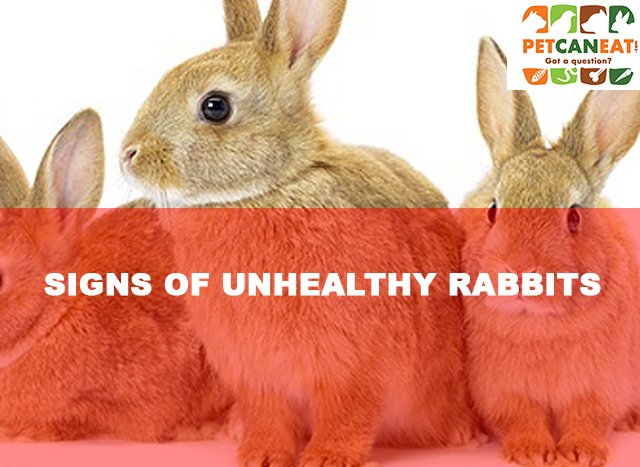
Is your rabbit healthy? Signs of unhealthy rabbits
Rabbits do not show signs of illness easily. In the wild, a rabbit showing signs of weakness, injury, or illness would be an easy target for predators, so it’s crucial to ensure that you pay close daily attention to your rabbit’s behavior.
Marie Channer, head of small animal welfare at Wood Green, suggests: “Rabbits should be visually health-checked every day and thoroughly health-checked every week. Rabbits are a prey species, so they will not let you know that they are poorly until the last minute; it’s important that you pick up even the smallest change in behavior.”
A healthy rabbit should:
- Move freely and comfortably without any signs of discomfort or lameness.
- Be able to hop up and down small steps and explore his environment.
- Unless he is molting, your rabbit’s coat should be sleek and shiny with no sign of parasites.
- His eyes should be bright and alert without any sign of soreness or injury.
- There should be no nasal discharge — this may indicate a respiration issue.
- The nose should twitch roughly in time with your rabbit’s breathing; he should never breathe through his mouth.
- Check around the mouth for signs of drooling or saliva -—this may indicate a problem with chewing, which could be associated with dental disease.
- Your rabbit should hold his ears correctly, depending on his breed. Ears should be clear and clean.
- Your rabbit’s rear end should be clear of any feces; pay particular attention to this if your rabbit is long-haired or if he is elderly.
- Your rabbit should be eating a normal amount every day. Remember to note exactly how much your rabbit eats daily so you can ensure that he is eating the same amount each day.
- Check that your rabbit’s feces are normal size and consistency; look for any signs of diarrhea or small, dry poos.
Once a week, place your rabbit on a towel on a flat surface so you can do a detailed nose-to-tail health check, paying close attention to the points mentioned above.
What is Rabbit Neutering?
This is commonly seen in female rabbits that aren’t spayed at the correct age. Neutering your rabbits can help prevent unwanted babies, uterine cancer, and behavior problems such as aggression. While spaying is an invasive form of surgery, the benefits greatly outweigh the risks, and they can also become easier to train.
Some common illnesses in rabbits
Here are some of the most common illnesses many rabbits experience during their lifetime.
Flystrike
From April to late summer, you should check your rabbit daily for any signs of flystrike, especially if your rabbit has encountered this kind of problem before. A common cause of flystrike is obesity – it is recommended that you use litter trays to remove feces each day easily. Check his rear end for wastes and urinary staining signs, which will matt the coat, causing bacteria to grow and creating an ideal place for fly eggs to hatch. The rear area should be clean and dry at all times. Elderly rabbits, obese rabbits, hutch/indoor cage bound rabbits, and long-haired rabbits should be checked daily as it can affect them any time of the year – more so in hot weather.
Rabbit Dental disease
Rabbits’ teeth constantly grow, so they will need a diet that’s high in fiber to keep their teeth ground down. Dental disease is challenging to spot in rabbits — their mouths are small, narrow, and deep, so problems are often not seen until it’s too late. In rabbits suffering from dental issues, it’s often not until rabbits begin to stop eating from the pain that owners are aware that there are any issues. Regularly weigh your rabbits and check that the front teeth touch together.
Digestive issues
It’s important to pay close attention to your rabbit’s toileting routine as any changes in this could indicate a problem. Shock, stress, and pain can all cause digestive disturbances in your rabbit. Occasionally a digestive blockage may occur — if you suspect that this is happening with your rabbit, seek veterinary advice immediately.
Caecotrophs are dark, smelly, shiny, soft droppings that rabbits eat as they emerge from the bottom; they are only occasionally seen. If you find these pale stools often, it is a sign that something is wrong.
It may be that your rabbit is unable to reach round to his bum due to his age or weight, or he may have painful teeth, which means he will not want to eat. It could also indicate a worm infestation.
The most common cause, though, is an incorrect diet. A poorly balanced diet without enough fiber, with too many proteins or carbohydrates, or even being fed too much may mean your rabbit doesn’t want to re-digest the diet. If you spot this problem, take your rabbit to the vet for a full health check to ascertain the situation. A sticky bum can increase your rabbit’s chance of flystrike, so it’s essential to treat this properly.
Myxomatosis in Rabbits
This viral disease killed thousands of wild rabbits in the 1950s. The virus is spread by biting insects or directly from rabbit-to-rabbit contact. Pet rabbits that live outside are at a greater risk as they are more likely to contact wild rabbits, hares, or rabbit fleas. Pet rabbits have no genetic immunity against myxomatosis, and vaccination with the recommended booster follow-up is HIGHLY recommended. Vaccinated rabbits can still contract the disease, but the symptoms — which include runny eyes and conjunctivitis, swellings on the head, and puss lumps that cover the body — are much less severe. Treatment of vaccinated rabbits is much more successful, and with proper veterinary care, the survival rate is relatively high.
There are two forms of myxomatosis: one causes pneumonia and a snuffle-like illness; the other (Nodular myxomatosis) mainly affects the skin and carries a better prognosis.
Treatment for unvaccinated rabbits is generally futile, and euthanasia is usually recommended.
How to prevent myxomatosis in rabbits
To avoid contraction of myxomatosis:
- Buy hay from farms free from myxomatosis.
- Fit insect screens to outdoor hutches and runs
- Eliminate standing water from your garden (and preferably from any neighboring gardens as well!) where mosquitoes could breed
- Avoid any contact with cats or dogs who may have been hunting infected wild rabbits.
- Ensure that outdoor rabbits cannot make contact with wild rabbits
- If your rabbit has any signs of fur mites (e.g., dandruff on the back of the neck), take him to the vet for prompt treatment.
Common skin problems and complaints in rabbits
Ringworm
A fungal infection that causes itchy sores, usually on the head. The infection is easily treatable with anti-fungal medication. Ringworm can be passed from rabbits to humans, so it is important to handle infected animals carefully, using gloves and limiting contact with your rabbit during treatment.
Fleas and mites
Mite infestations generally look like dandruff patches on the coat. They are often seen in hard-to-groom places at the base of the tailor the nape of the neck and can be more common in older or long-haired rabbits who will find grooming more difficult. Anti-flea treatments for both your rabbit and for his living environment are available from your vet. Flea infestations are not common in rabbits but can occur in multi-pet households, particularly if you own cats or dogs. Fleas can carry the myxomatosis virus, so a good flea control program, which treats all the animals in your household, is essential.
Ear mites
These invade the ear canal, causing irritation and creating a crusty discharge from the ear. Signs include increased ear scratching, soreness in the ear, and eventually a brown scaly crust within the ear. Your vet should treat them.
Sore hocks (pododermatitis)
This can be caused by various things, including poor hygiene in the environment, long nails causing too much weight on the heel, obesity, immobility, and unsuitable flooring. Adult rabbits should have a small bare pink callused area at the tip of the heel, covered by a fold of fur. If this area is red, inflamed, and weeping, then your rabbit has ‘sore hocks. The underlying cause should be identified and rectified, while you can treat the sores with anti-inflammatories and painkillers.
Wounds, lumps, and bumps
Depending on the severity, these have various causes and will need to be carefully cleaned and seen by your vet.
Viral Haemorrhagic Disease
A deadly disease that both pet and wild rabbits can catch. A vaccination is available to protect your rabbit from this disease, increasing in the wild rabbit population, particularly in certain areas. You can catch the disease from food contaminated by infected rabbits, birds, or insects that transfer the disease in their droppings.
It may have been blown in the wind, or you may even bring the virus home on your feet via infected droppings.
VHD can cause sudden death in older rabbits, or they may just get mildly ill and recover.
It does not affect rabbits under the age of eight weeks. It is entirely preventable, firstly by ensuring your rabbit is vaccinated and that you keep up-to-date with the necessary boosters. Good hutch hygiene and ensuring that wild animals, vermin, and birds cannot get into your rabbit’s hutch can also help. Don’t pick grass from areas where wild rabbits might live, and try to prevent wild rabbits from having nose-to-nose contact with your rabbit.
Obesity in Rabbits – Is my rabbit obese?
Obesity is a major health concern in the pet population, and issues in rabbits are no exception. You can help to keep your rabbit in shape by ensuring that:
- He has plenty of space to run around and exercise.
- He is fed on a balanced diet.
- He is not over-fed – a small handful of the pellet a day to compliment adlib hay. Fruit and carrots are also very fattening.
- He is not fed too many treats.
A good vet: You must register with a local vet who has experience handling rabbits. Do your research before bringing your rabbit home and visit the vet before adoption to talk about vaccinations and neutering.

